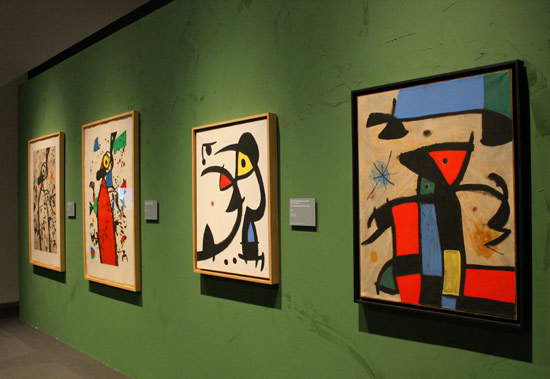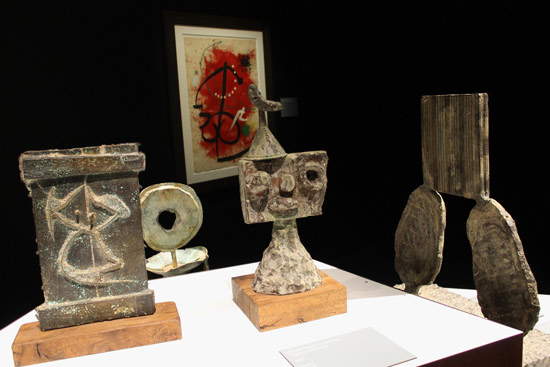A Punyet between Joan-Miró and her grandson is done. Joan Punyet Miró is the deity of Successió Miró and the spokesman for Joan’s poetics. A cultured grandson of art without snootiness, as soon as he is asked about his grandfather his eyes sparkle and his prose begins to sing the poetry of thevo: a magical and eternal dreamer, I always carry a wonderful memory of him. Enthusiasm is contagious and saturates every tale and memory, whatever the theme, whatever the latitude. From poetry in painting suspended between earth and sky, to the rawest and most experimental material shaped in the blood of feverish hands. Those of a peasant artist-as he used to call himself- hovering between the unconscious and the dreamlike. Like the figures and signs that populate and float in his paintings.
A brief foray into the work of Joan Miró (1893-1983) through the voice of Joan Punyet, on the occasion of the retrospective that Milan dedicates to the Catalan artist. One hundred works from the Foundations of Palma de Mallorca and Barcelona on the move to the Museo delle Culture from March 25 to Sept. 11, 2016. In the shadow of Chipperfield’s azure cloud transparencies, amid soft lighting and jazz rhythms, The Force of Matter is lit. An alchemical blend of painting, poetry and sculpture that animates characters carved in bronze and primary colors furrowed by the violence of black on the walls.
 |
| Image from the Miró exhibition at Mudec in Milan. |
Luca Zuccala. Dim lights, jazz music and grandfather’s works on the walls. Joan Miró’s biomorphic visions shine at Mudec in Milan. Satisfied with the installation?
Joan Punyet Miró. Very. I like it because it is nocturnal, enigmatic. The color of the walls, the chiaroscuro and the mysterious luminosity make the atmosphere vibrate.
A nice alchemy with the Blues for Joan Miró in the background improvised by Duke Ellington in 1966 just after meeting him. Here, speaking of alchemy -a fundamental as much as an ambiguous element in Miró’s oeuvre- can we speak of osmosis between artist and work, between his spirit and the subject matter?
Certainly. Even today alchemy is an enormous mystery, as well as being very dangerous. When a person works with a material, every single atom and molecule of this material enters into the artist’s skin. It is the symbiosis of the blood, the hand, the foot, the form. The material inside the blood forms a spiritual communion with the artist’s body. And this communion forges a different spirit that implements a symbiosis with the material that worked it. This is the alchemy. Being in direct contact with the material that penetrated my grandfather’s epidermis and produced a magical substance. A mixture with his blood.
 |
| Joan Miró, The Two Friends (1969; etching, aquatint and silicon carbide, 71.5 x 106.5 cm; Barcelona, Fundació Joan Miró) |
Miró was a mad experimenter. He used the most diverse media, including wood.
For my grandfather, wood has a magical component. It was a revolutionary idea to use it dirty and raw. He in fact was never dogmatic and institutional. He didn’t work all his life with classic media and materials, but he did a real investigation of unconventional media such as precisely wood, which was recycled by my grandfather to be worked on in the Majorca studio.(NDA: From 1956 until his death in 1983, Joan Miró resided on the island of Majorca, where he carried out an intense creative activity. The Majorcanstudio was named Sert after the architect who conceived it in the hills of Cala Major in Palma.)
Working with wood was part of theantipainting he was researching. Miró wrote that antipainting is a rebellion against a state of mind and against traditional painting techniques. An attempt to express myself through new materials: bark, textile fibers, collage. And, of course, dirty and recycled wood.
Antipainting because Miró was making a direct material test with an abrasive wood, a destructive wood, a pure wood that spoke of material truth. About the strength of matter. These are automatic, gestural, rapid works that even when he was 80 years old highlight a man’s moral and artistic need. The work, charged with violence and rebellion, in his later years represents the most dramatic evolution of his symbology.
Miró really wanted to “kill painting.”
The first thing was just that: the clear rejection of any pre-established pictorial idea. To kill traditional painting.
A goal pursued through relentless experimentation accompanied by an American-style gesturality and a fascination with Oriental calligraphers.
Jackson Pollock and Franz Kline, for example, are very important artists for Miró, as fundamental was the influence of Japanese culture and its magical graphism. My grandfather visited Japan on two occasions three years apart (1966, 1969). He was deeply attracted to the Japanese conception of nature, calligraphy, the stroke and haiku (musical notes and calligraphic signs) poems.
 |
| Image from the Miró exhibition at Mudec in Milan. |
Main influences beyond American abstract expressionism and Japanese graphism?
Poor art, formalism, the tachism of Fautrier and Dubuffet, the musicality of Kandinsky.
He has managed to fuse them into a language of apparent simplicity that encapsulates a world populated with signs, symbols and dreamlike characters, the result of work, discipline and training. Nothing, or almost nothing, is by chance in Miró.
That’s right. Order, rigor, discipline. A training that lasted his whole life until he died at the age of 90. His whole life was absorbed in his work. He was always extraordinarily vital and creative. An erupting volcano. At age 80, I remember, he kept working all day long without stopping, innovating, disrupting, experimenting. Trying and trying again to bring his world, his work, to life.
An oeuvre populated with signs and forms as naive and innocent as they are rich in experience, dreams and worlds. A universal poetics, an alphabet understandable to all. This ensured that his message reached everyone and was more successful than many other artists contemporary to him. And not only that.
Because it is a painting that is very different from everything else. It cannot be categorized. For example, if we talk about metaphysical painting we talk about De Chirico, Fontana spatialism, and so on. Miró is different: Miró is an iconoclastic, revolutionary, dreamer artist who created an alphabet that was felt and loved by everyone, at all levels.
And even in the Surrealist sphere-he adhered to the 1924 manifesto while always remaining free and independent-he turns out to be the most beloved.
Because Miró is a magical artist. An alchemist of the sign with a maximum spiritual communion with the force of matter. Miró’s mystery is a pure and spiritual attraction. And timeless. Delvaux for example is too figurative, Dalí too linear. Miró is an alchemical and poetic artist who achieved a magical symbiosis with wood and so many other materials, which made his surrealist poetics and language even stronger.
 |
| Image from Miró’s exhibition at Mudec in Milan. |
Warning: the translation into English of the original Italian article was created using automatic tools. We undertake to review all articles, but we do not guarantee the total absence of inaccuracies in the translation due to the program. You can find the original by clicking on the ITA button. If you find any mistake,please contact us.